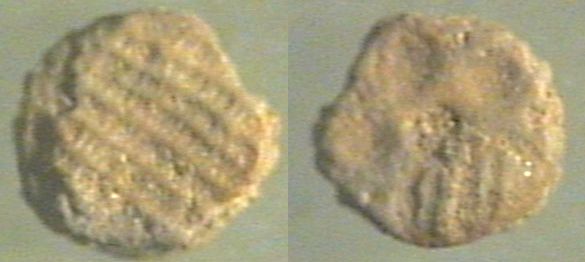
In the countless hours I have spent sorting through the "Cyclora Fossil Hash" material picking out mystery fossils, I began to find ridges, some similar to the mystery fossil ridges, on crinoid columnals. This may be the result of secondary phosphatization, through a similar process to what may have formed the mystery fossil ridges. The ridges on the specimen below appears to be the impression of the surface of the brachiopod Rafinesquina sp..

In the above photo, a crinoid columnal is completely embossed with ridges on one side and shows signs of ridges on the other. The ridges on the first side has light transecting lines. I can only speculate as to what made these lines. They could be pelecypod or brachiopod valve external features with the light transecting lines being growth lines. It is likely, though, that the lines came from the crinoid columnal being in contact with the surface of another object.
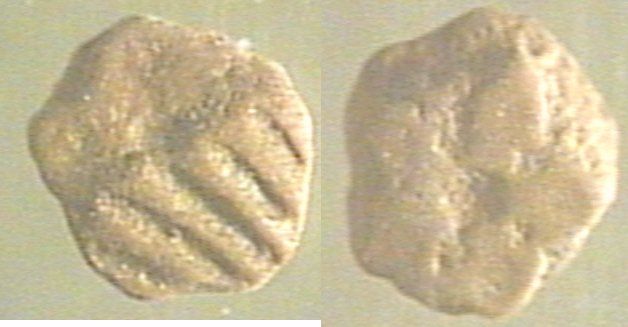
This crinoid columnal (above) has ridges on one side that are similar to the mystery fossil ridges. Unlike the mystery fossil ridges, however, these ridges are the same color and texture as the material preserving the columnal. The stereom is not visible.
The Mystery Fossil "Nodules"
Most of these mystery fossils appear to be filled with material similar to what is found loose in the Cyclora fossil hash. One of the most abundant objects of this size are tiny gastropods. I have found several good examples where these gastropods are clearly inside the mystery fossil.
The "nodule" extruding from the right side of this mystery fossil looks to be a gastropod steinkern. After popping one of these gastropods out of the mystery fossil specimen, I have observed a smooth surface in the cavity where the gastropod was. The gastropod has the same preservation as the loose gastropod internal molds found in the surrounding material. That is to say the steinkerns have no shell remains and have smooth exteriors.
The fact that I could pop the gastropod steinkern out of the "Mystery Fossil" interior demonstrates that the gastropod steinkern was formed first and then inserted into the "Taco" that became my Mystery Fossil.
I wonder if there is small hashy fossil material inside the gastropod mold! Perhaps included are small bits of Echinoderm plates showing stereom if thin sectioned. Perhaps this is worth doing. The "Cyclora Fossil Hash" layers of the Arnheim have been known for a long time. The processes which preserved these tiny snails has not been widely published. I'm willing to bet the smooth surface on these gastropod steinkerns is just as much a coating on the gritty interior as my Mystery Fossil has!
The photo below shows one of the mystery fossils with what appears to be a crinoid columnal sticking out of it. In this picture, both sides of the specimen are shown. After taking this picture, I tried to break this specimen open to confirm that it is a crinoid stem and the whole thing crumbled. Ooops. I guess that wasn't the thing to do. It is the only specimen I have seen with a single nodule this big. It was a flat disc like a crinoid columnal.
This next specimen, pictured below, appears to be an irregularly shaped nodule with the usual "mystery fossil" ridged outer coating that is partially gone. Close examination reveals that the surface of the nodule has small pores. Below are images showing the two sides of the specimen (60X) followed by a couple of close-ups (200X) showing the pore structure. These apparent pores are likely to be the tubular structure seen in the thin sections.
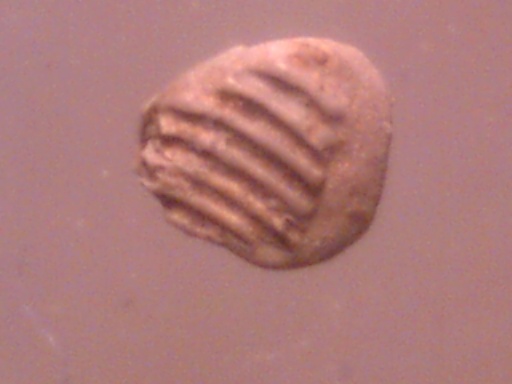
Side 1

Side 2
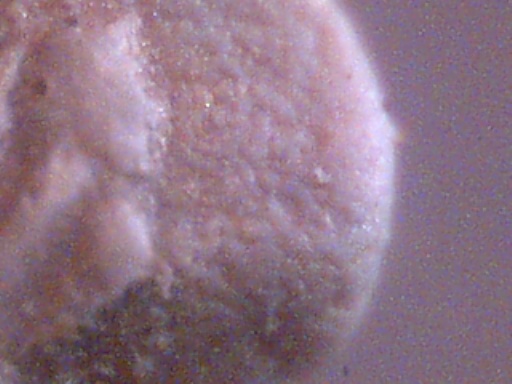
A 200x enlargement of side 2 showing pores or stereom.
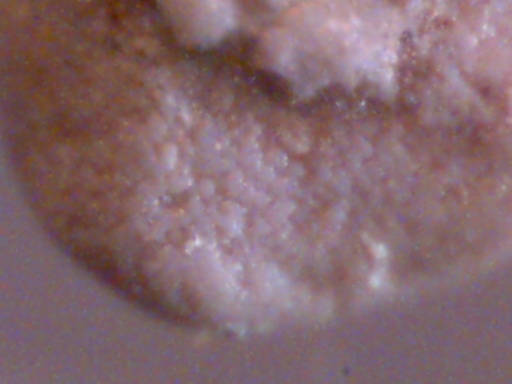
Another 200x enlargement of side 2. Are these bumps stereom?
Are these varied "nodules" evidence that the mystery fossil was a cavity in some animal which housed hashy material? If so, then the ridges on the surface of the mystery fossils may be the impression of the surface of these cavities. So far, my best guess is that hashy material lodged between the hinge teeth of a single pelecypod valve. Some of the late Ordovician pelecypods had ridges on the sides of each hinge tooth (such as Lyrodesma major). Click here for a description of this "Pelecypod Hinge Teeth Hypothesis".
Bill Heimbrock
1621 Westwood Ave
Cincinnati, OH 45214
(513) 921-2335
billheim@xfossils.com
Uncover the Mysteries of Deep Time at Xfossils.com.
Amateurs Advancing Paleontology
Back to mystery fossil main page